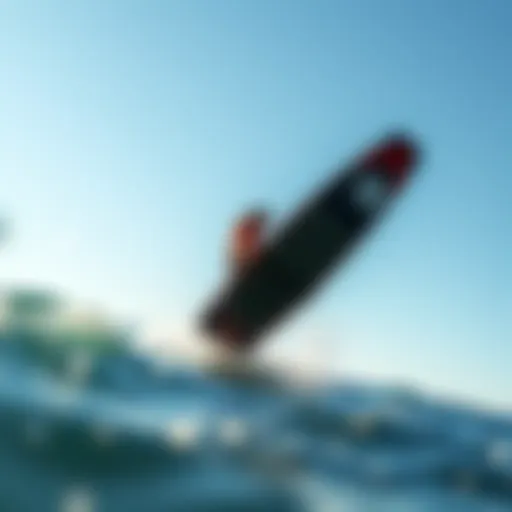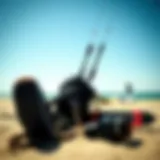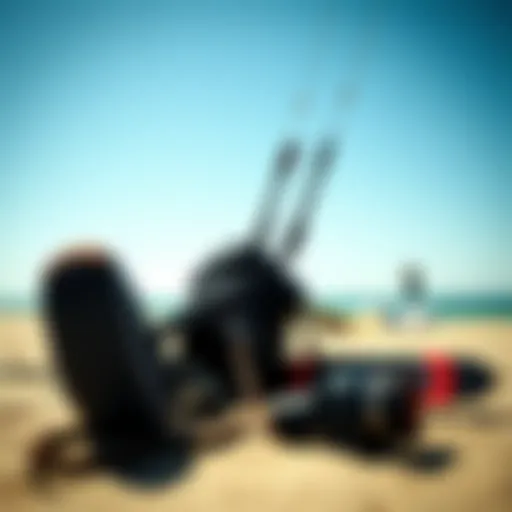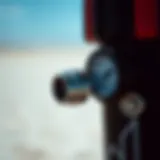Exploring the Carafino Hydrofoil in Kiteboarding
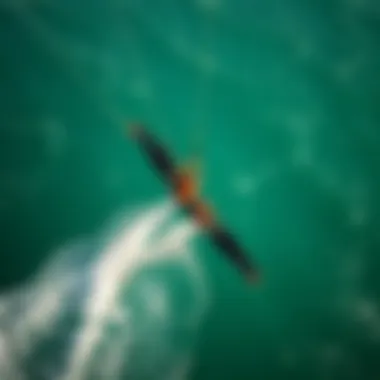
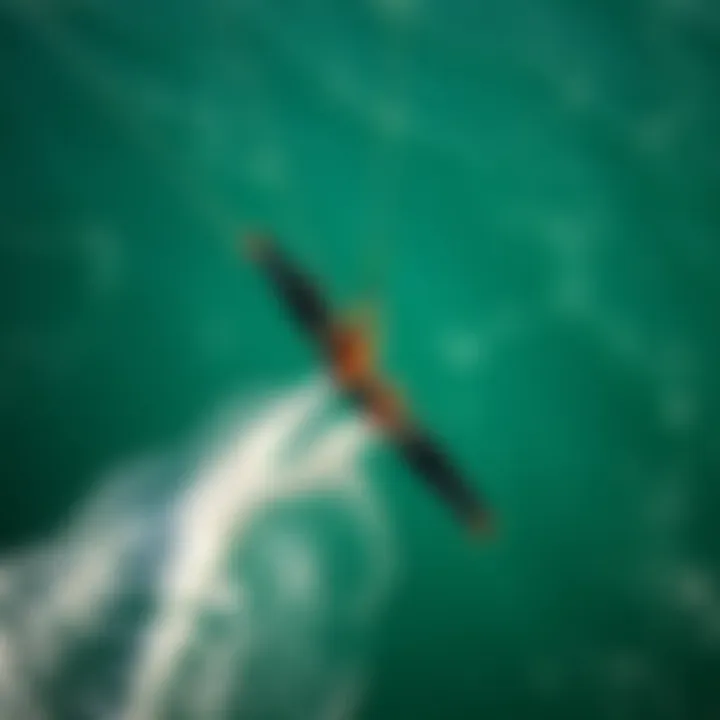
Intro
Kiteboarding has been a dynamic and exhilarating sport for those who crave both adrenaline and adventure. Among the latest advancements igniting discussions in the kiteboarding community is the Carafino hydrofoil. Unlike traditional boards, a hydrofoil allows kiteboarders to glide above the water's surface, providing a unique riding experience marked by enhanced speed and agility. Anyone who's ever felt the thrill of catching air while kiting will appreciate how this gear reshapes the landscape of the sport.
The Carafino hydrofoil is not merely a piece of equipment; it's a statement of innovation that fuses art with engineering prowess. As enthusiasts venture into this new realm, understanding the nuances of the hydrofoil becomes paramount. What exactly does it bring to the table? How can it elevate a rider's skills? And what should beginners know before diving into this high-flying experience? Each question unveils layers of complexity that merit exploration.
In this article, we'll take a closer look at the Carafino hydrofoil, dissecting its design elements, performance metrics, and suitability for riders at varying skill levels. Whether you're a seasoned pro or just setting foot on the sandy shores of a kiteboarding beach, the potential of the Carafino hydrofoil is worth understanding. Through its innovations, riders are not just getting a taste of speed; they are stepping into the future of kiteboarding.
Prelude to Hydrofoiling in Kiteboarding
Hydrofoiling in kiteboarding has taken the world of water sports by storm. This innovative technology has transformed how enthusiasts experience riding, lifting them above the waves and into a realm of speed and performance that was previously inconceivable. But what makes hydrofoil equipment a game changer? This section casts a spotlight on the essentials of hydrofoiling, shedding light on why it merits attention from both seasoned kitesurfers and newcomers alike.
Understanding hydrofoiling entails diving into the mechanics of how a rider can seemingly float above the water, propelled by a kite while the board remains lifted by the hydrofoil. The efficiency with which a hydrofoil glides through water diminishes the impacts of surface friction, allowing riders to cruise at higher speeds with far less effort. Riders can experience longer rides, smoother transitions, and a thrilling feeling akin to flying, which is a primary allure of the hydrofoil technology.
What’s more? Hydrofoiling opens doors to varied riding conditions. Whether it’s choppy waters or light winds, hydrofoils facilitate kiteboarding experiences that are not confined to ideal weather conditions. This versatility ensures that kiteboarders can venture out more often, effectively boosting their skills and enjoyment of the sport.
As we examine the intricacies of hydrofoiling, it becomes apparent that beyond just performance metrics, there's a rich history and a complex interplay of design and engineering behind the technology. Understanding this narrative not only enhances appreciation for the sport but also impacts how enthusiasts engage with it.
By the end of this exploration, readers will find a wealth of information that pulls together the various threads of hydrofoiling, performance benefits, design considerations, and user experiences.
Understanding Hydrofoil Technology
At its core, hydrofoil technology involves a lift-generating structure that extends below the water's surface. When a kiteboarder gains enough speed, this structure – known as a hydrofoil – allows the board to rise above the water. The basic components generally comprise a mast, fuselage, and two wings. Each part plays a unique role in ensuring the rider maintains balance and achieves acceleration.
The lift generated by hydrofoils makes use of Bernoulli’s principle, which states that as the speed of a fluid increases, its pressure decreases. Thus, as the hydrofoil cuts through the water, the pressure below the wing drops while the pressure above it remains higher, producing upward lift. This principle essentially explains the magic at play when riders feel that glorious sensation of flying over the surface.
One crucial aspect that may escape the casual observer is that not all hydrofoils are created equal. Various designs yield different performance outcomes. Factors such as surface area, aspect ratio, and wing shape can significantly influence how a foil behaves in the water, affecting attributes like speed, agility, and stability.
A Brief History of Hydrofoils
Hydrofoiling is not a new concept; it has its roots stretching back to the early 1900s. The earliest patents surfaced in the 1890s, but true advancements weren't realized until much later. Notable figures, such as the Italian engineer Emanuel (Manie) Carafino, have made significant strides in developing efficient designs that laid the foundation for modern hydrofoils used today.
The journey from experimental crafts to kitesurfing foils showcases a blend of engineering innovation and creative spirit. Initially relegated to the realm of racing and engineering challenges, hydrofoils gained widespread popularity in the watersport community during the late 20th century. This growth parallels advancements in materials technology and satellite communication, enabling precision engineering and responsive designs.
Today, hydrofoils have emerged as a standard in kiteboarding and several other water-based sports, leading to the birth of entire subcultures within these activities. As we continue to explore the Carafino hydrofoil specifically, it becomes apparent how these historical advancements contribute to the enhanced riding experiences available to enthusiasts now.
"The beauty of hydrofoiling is that it transcends the conventional, opening up possibilities for all riders to tap into the essence of flight and speed on water."
Carafino Hydrofoil Design
In the world of kiteboarding, the design of a hydrofoil can significantly influence performance and rider experience. The Carafino hydrofoil exemplifies innovation in this area and solidifies its importance through meticulous design principles that blend art and science. The framework of this hydrofoil is crafted not merely for aesthetic appeal but for high functionality that can elevate the riding experience for both novices and experts.
Materials and Construction Techniques
When examining the Carafino hydrofoil, one must appreciate the materials and construction techniques employed in its creation. The choice of materials has a profound impact on durability and performance. Lightweight yet robust materials like carbon fiber dominate the design. Carbon fiber boasts a high strength-to-weight ratio, contributing to a sleek profile that minimizes drag while ensuring structural integrity.
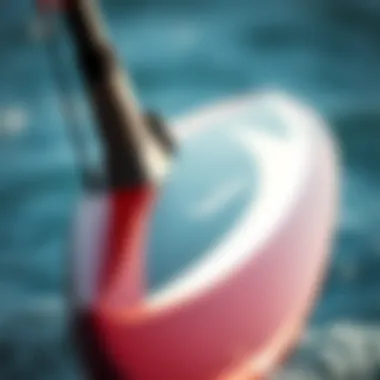

There’s a meticulous process involved in assembling the hydrofoil. The layers of carbon fiber are laid down with precision, often using vacuum infusion methods to enhance adhesion and minimize air pockets. This construction technique ensures the hydrofoil achieves optimal buoyancy while remaining responsive in varying conditions.
Another key feature in Carafino’s design philosophy is the importance of maintenance ease. Riders appreciate products that offer longevity with minimal upkeep. Hence, coatings that resist corrosion and UV damage are applied, ensuring that the hydrofoil remains in top condition despite exposure to harsh marine environments.
Key Considerations in Material Choice:
- Weight: Reducing overall weight improves lift-off speeds and maneuverability.
- Durability: Weather-resistant materials enhance product lifespan.
- Flexibility: The hydrofoil needs to maintain stiffness for performance while allowing some flex to absorb shock.
Hydrodynamics and Performance Optimization
Discussing hydrodynamics is crucial to understanding how the Carafino hydrofoil achieves its remarkable performance metrics. The design focuses on optimizing the blade shape and aspect ratio to generate lift efficiently. The hydrofoil's wings are crafted to create a smooth flow of water, which translates to reduced drag and increased speed.
Performance optimization is where the Carafino truly shines. The wing's profile is designed to maintain stability while providing sufficient lift as the rider accelerates. An aspect ratio that’s higher than traditional foils can give increased efficiency, which is particularly beneficial for speed-focused riders.
Interestingly, feedback loops from experienced riders have informed adjustments in blade design, continually refining the hydrofoil’s responsiveness under various kite forces. This adaptability ranks high on the list of features that appeal to both recreational users and competitive riders alike.
Additionally, the integration of intuitive control surfaces allows for fluid maneuvering—a hallmark of advanced kiteboarding. Testing has shown that riders can experience smoother transitions and turns without sacrificing speed or control, making the Carafino a sought-after choice.
“With the right hydrofoil, kiteboarding morphs into flight rather than just a water sport.”
Performance Characteristics
The performance characteristics of the Carafino hydrofoil play a crucial role in determining how effectively a kiteboarder can harness wind and water, translating raw strength into fluid motion. Sifting through the details of speed, maneuverability, stability, and control is paramount for riders who seek to enhance their skills and experience. Each characteristic contributes uniquely to the overall riding experience, shaping not only the technical dynamics of riding but also how an individual connects with nature on the water.
Speed and Maneuverability
When we talk about speed in the context of the Carafino hydrofoil, it's essential to understand that it transcends simply gliding over water. Speed is about translating power effectively, ensuring that each gust of wind accelerates the rider in a seamless manner. The Carafino hydrofoil, with its specifically designed wings, reduces drag, allowing the rider to achieve impressive speeds without much extra effort. Riders often report feeling as if they are flying just above the water's surface—an almost ethereal sensation.
Maneuverability complements speed by giving riders the ability to cut through the waves and turn sharply without losing momentum. The hydrofoil reduces surface contact, allowing for swift direction changes that seasoned kiteboarders cherish in their rides. Riders often mention how responsive the Carafino can be, almost like a trusted dance partner on the water. The combination of speed and maneuverability not only boosts performance but also instills confidence in individuals willing to push their limits.
"With the Carafino hydrofoil, I can go from 0 to gliding in a split second—it's a game changer!"
However, achieving optimal speed requires accustomed technique. Newer riders should approach this characteristic with caution, as the thrill of speed can quickly lead to unwanted tumbles if not managed properly. Learning to maintain balance while kiting, especially at higher velocities, comes with practice and patience, emphasizing that speed is as much a skill as it is a characteristic of the hydrofoil itself.
Stability and Control
Stability in hydrofoiling refers to the ability to maintain a consistent ride without excessive bouncing or wobbling. The Carafino hydrofoil is engineered to deliver just that. Its design ensures that once a rider is up and flying, they can experience an unparalleled sense of stability. This stability is not merely a function of materials used but is also influenced by how the hydrofoil interacts with water currents. Riders can glide over choppy water or navigate gusty winds with a solid grip on their board, ensuring a more enjoyable ride.
Control in kiteboarding, particularly with hydrofoils, is a rider's best friend. The Carafino allows users to fine-tune their relationship with the kite, adapting their movements based on environmental conditions. This adaptability is particularly essential for navigating through unpredictable waters. As riders become attuned to the subtle nuances of their equipment, they find they can make micro-adjustments—slight shifts in weight or angle that can result in significant differences in handling.
It is important to note that while the Carafino hydrofoil excels in stability and control, it requires a degree of rider intuition. Understanding how to adjust posture, shift weight, and utilize kite power smoothly can take time, particularly for beginners. Therefore, continued practice is crucial to mastering the unique sensations and controls that the Carafino hydrofoil offers.
In essence, the performance characteristics of the Carafino hydrofoil—speed, maneuverability, stability, and control—form the backbone of what makes this piece of equipment so advanced. Premium experience stems from elements working in tandem to elevate every session on the water.
User Experience and Adaptability
In the world of kiteboarding, the user experience can make or break the joy of riding the waves. The Carafino hydrofoil stands out in its focus on adaptability, catering to both budding enthusiasts and seasoned experts. This adaptability isn’t merely a feature; it encapsulates the essence of what makes a hydrofoil truly enjoyable and effective for riders at varied skill levels. By balancing ease of use with performance, the Carafino hydrofoil opens up the sport to a wider audience, inviting those who may have previously felt intimidated by the complexities of hydrofoiling.


Beginner-Friendly Features
For newcomers to kiteboarding, the steep learning curve can sometimes feel like a mountain too high to climb. However, the Carafino hydrofoil includes several beginner-friendly features aimed at smoothing that often bumpy transition.
- Stability: The design incorporates elements that contribute to stable rides, reducing the chances of nosedives, which can be a common concern for beginners.
- Adjustable Foil Height: Riders can easily modify the foil height, allowing for a gentler experience when starting out. This feature is particularly useful for those who are still learning to balance or gauge their speed.
- User-Centric Design: The materials and structure are crafted to offer lightness without sacrificing robustness. This design enhances buoyancy, allowing beginners to grasp control without feeling weighed down.
- Clear Instructions and Support: Carafino is keen on separating themselves from their competitors by offering detailed user guides and customer support that assists new riders in grasping the nuances of hydrofoiling.
These elements converge to create a welcoming package for those new to the sport. The confidence gained through such a supportive design can make learning and progress smoother.
Advanced Rider Suitability
While catering to novices is undeniably important, the Carafino hydrofoil does not lose sight of experienced riders. For those who have already mastered the fundamental skills, the performance dynamics of the hydrofoil offer depth and excitement. Advanced riders will appreciate aspects designed specifically to push their limits.
- Thrilling Speed Potential: The hydrofoil is engineered for speed. With the right conditions and rider technique, it allows for exhilarating rides that make every session feel unique.
- Precision in Control: With a well-thought-out hydrodynamic design, advanced riders can perform tricky maneuvers and adjust their stance quickly. The responsiveness of the foil means that riders can trust their equipment to follow through on their intentions.
- Customization Options: Carafino allows proficient riders to make specific adjustments based on personal preference. Riders can tweak settings that suit their style, whether that be for aggressive carving or graceful gliding.
- Durability Under Pressure: The robust construction means that experienced riders can push their gear to the limits without worrying about wear and tear. This durability provides a peace of mind that invites exploration of new techniques.
In fostering a spectrum within rider experiences, the Carafino hydrofoil not only enhances individual performance but also cultivates a community. From the first-time rider to the seasoned pro, there’s a niche for everyone, ensuring that everybody can find pleasure riding the same waters.
Safety Considerations
In the realm of kiteboarding, safety is more than just a buzzword; it's a fundamental aspect of the sport. When it comes to innovative equipment like the Carafino hydrofoil, understanding the safety considerations is essential for both novices and seasoned riders alike. Hydrofoiling, with its unique dynamics and potential risks, necessitates a heightened awareness and proactive approach towards safety. As one navigates the thrilling waters, being equipped with the right knowledge and resources can greatly reduce risks and enhance the overall experience.
Risk Assessment in Hydrofoiling
When you hit the water with your Carafino hydrofoil, the excitement might take over, but it’s critical to pause for a moment and consider the potential risks at hand. The nature of hydrofoiling means that you’ll reach higher speeds and experience changes in balance compared to traditional kiteboarding. For instance:
- Environmental Hazards: Knowing the water conditions is key. Currents, waves, and wind can change rapidly.
- Equipment Failure: As with any mechanical equipment, wear and tear can lead to failures. Regular checks of your hydrofoil and kite are essential, ensuring everything is in tip-top shape.
- Inexperienced Pilot Maneuvers: Understanding the hydrofoil’s responsiveness is crucial. New riders might make abrupt movements, leading to falls or collisions.
To reduce risks, comprehensive assessment of both environmental conditions and personal skill levels is vital. Always consider whether the conditions are suitable for your current experience level. Going out with a buddy, especially for beginners, can also mitigate risks significantly.
Safety Gear Recommendations
Having the right safety gear is like having a seatbelt in a car; it doesn't prevent accidents, but it sure helps in mitigating the consequences. For hydrofoiling, attire should be tailored for function and protection. Here’s a rundown of must-have gear:
- Helmet: A properly fitted helmet protects your head from impacts, especially during falls. Options vary from lightweight designs that favor comfort to bulkier models that offer more protection.
- Impact Vest: Similar to those used in wakeboarding, a good impact vest can protect your torso and keep you buoyant if you do end up in the water unexpectedly.
- Wetsuit or Dry Suit: Depending on the water temperature, wearing a wetsuit (for milder conditions) or a dry suit (for colder climates) can prevent hypothermia and keep you comfortable.
- Leashes: Using a leash to secure your board can help prevent loss in choppy conditions, making it easier to retrieve it without exerting yourself unnecessarily.
- Footwear: Specialized kiteboarding shoes can protect your feet from sharp objects under the water and provide better grip on the board.
"Preparation in kiteboarding does not only ensures a smooth ride, it can save lives. Don’t cut corners with safety."
By prioritizing safety and following these recommendations, riders can truly enjoy the thrilling world of hydrofoiling while cutting down the risk of injury. Remember, a well-prepared rider is a confident rider, able to fully embrace the adventures that await.
Market Analysis of Hydrofoils
Understanding the market dynamics surrounding hydrofoils is crucial for anyone involved in kiteboarding, especially technicians, enthusiasts, and potential buyers. This segment sheds light on several key elements that can influence decisions around hydrofoil purchasing and development. Evaluating the competition and pricing structure not only drives awareness of what's available but also serves to enhance overall performance and safety in the sport.
Analyzing the market for hydrofoils provides insight into the trends shaping the industry and signals where innovations may arise. Furthermore, a deeper comprehension of the pricing structure ensures that riders understand the value they receive relative to the investment they make in equipment. This clarity ultimately fosters a more informed kiteboarding community.
Competition and Industry Landscape
The kiteboarding market is a bustling scene, with brands jostling to provide the latest and greatest in hydrofoil technology. Carafino, for instance, brings a fresh and innovative offering to the table, carving out a niche that resonates with both seasoned riders and newcomers alike. What sets Carafino apart, however, is not just the technology but their holistic approach to product design, which aligns practicality with an elevated riding experience.

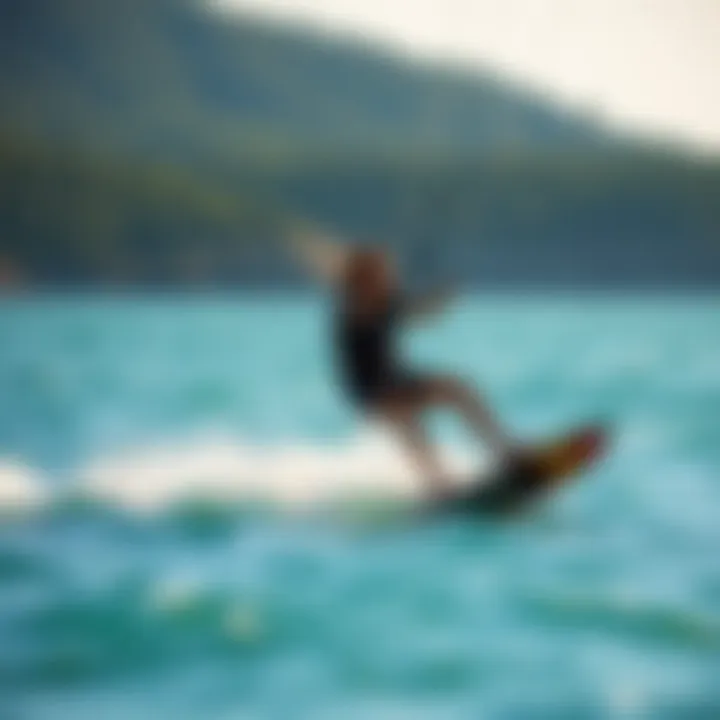
Several prominent players in the market create stiff competition. Brands such as Naish and Slingshot have long established reputations, often leading the charge with newer technologies. Moreover, smaller, emerging brands are picking up traction, focusing on customization and specialized designs that cater to targeted preferences. These dynamics shape consumer choices and determine how companies innovate and respond to market demands.
Riders often discuss their experiences on forums, such as reddit.com, where they swap technical insights and personal reflections. This grassroots engagement provides visibility to different brands and creates a sense of community. Observing these trends is key for understanding market sensitivities and evolving needs in hydrofoiling.
Pricing Structure and Value Proposition
When it comes to hydrofoils, the pricing structure can feel like a maze. The cost rises based on several factors, including materials, design complexity, and brand reputation. On a foundational level, basic hydrofoil packages might start around $800, while high-performance models can soar to $2,000 or more. However, price isn't merely a reflection of sticker value—it's about what each option delivers in terms of performance, durability, and user experience.
Riders must assess the value proposition of a hydrofoil by weighing its features against the cost. For instance, Carafino hydrofoils typically offer a unique balance of advanced materials and performance capabilities that appeal to a broad range of kiteboarders. The following elements are central to understanding this:
- Quality of Materials: Carbon fiber and aluminum offerings are common in higher-end models, enhancing durability and reducing weight.
- Performance Benefits: Enhanced speed and stability can justify a higher price point, especially for competitive riders.
- User Adaptation: A price tag might seem steep, but if a hydrofoil allows for quicker mastery of skills, it can be a worthy investment, particularly for newcomers seeking to advance rapidly.
The Future of Hydrofoiling
The landscape of hydrofoiling is steadily evolving. As kiteboarding enthusiasts continue to push the boundaries of performance and innovation, the future of hydrofoiling looks promising and dynamic. This section highlights some noteworthy developments, trends, and potential shifts in the market. Understanding these trends is crucial not just for manufacturers, but for riders and instructors alike, as they provide insights on how to stay ahead in a sport that is constantly changing.
Emerging Trends and Innovations
Hydrofoiling isn't just a fleeting trend; it's transforming into a mainstay in the kiteboarding realm. Riders are witnessing innovative advancements that significantly enhance performance and user experience. One key trend is the increased utilization of lightweight, high-durability materials such as carbon fiber, which reduces drag and improves maneuverability.
- Smart Technologies: Integration of smart technology within hydrofoils is gaining ground. From built-in sensors providing real-time data on speed and height to automatically adjusting foils based on water conditions, these innovations contribute to a seamless riding experience.
- Eco-Friendly Designs: An increasing awareness surrounding environmental impact is influencing material choices. Manufacturers are exploring sustainable options that align with the values of environmentally-conscious riders.
- Customizable Options: Tailoring equipment to suit individual preferences is on the rise. Consumers are looking for hydrofoils that offer adjustable wingspans and designs, allowing for personal optimization based on skill level, riding style, and local conditions.
These innovations broaden the spectrum of what's possible in hydrofoiling. Whether it's for professional competitions or casual outings, the technology that supports the activity is becoming increasingly sophisticated.
Anticipated Market Shifts
Looking down the line, significant shifts in the market are on the horizon as the popularity of hydrofoiling burgeons.
- New Demographics: The demographic of kiteboarders is diversifying. Once dominated by younger thrill-seekers, an uptick in older enthusiasts and newcomers to the sport is apparent. This shift drives demand for user-friendly designs that cater to all age groups, not just seasoned veterans.
- Global Expansion: Many regions that were once reluctant to embrace kiteboarding are now warming up to the idea, particularly in areas with favorable wind and water conditions like Southeast Asia and South America. This geographic spread opens up markets for new retailers and instructional schools.
- Collaborations: Collaborative efforts between brands and athletes are expected to grow. When riders partner with manufacturers, the resulting dialogue can yield cutting-edge innovations and improvements, ultimately benefitting the entire kiteboarding community.
As the kiteboarding scene continues to evolve, remaining attuned to these emerging trends and market shifts allows enthusiasts and professionals alike to keep their finger on the pulse. Hydrofoiling is not just here to stay; it’s on a trajectory to redefine the kiteboarding experience, paving the way for thrilling adventures and uncharted waters.
Culmination
In synthesizing the information regarding the Carafino hydrofoil, we can clearly see its pivotal role in advancing kiteboarding technology. This article underscores how the unique design and engineering of the Carafino not only enhance performance but also reshape the riding experience for enthusiasts at all levels. The Carafino Advantage lies not just in its materials but in how its innovation translates into tangible benefits for the rider.
Recapitulating the Carafino Advantage
The Carafino hydrofoil is more than just a tool; it's an extension of the rider's capabilities. Here are some key aspects that highlight its advantages:
- Enhanced Lift and Speed: This hydrofoil is designed to provide an exceptional lift while minimizing drag. Riders often notice the difference when catching the wind, sailing closer to the water's surface whilst achieving higher speeds.
- Stability in Varied Conditions: The hydrodynamic shape allows for a smoother ride even in choppy waters. Riders can enjoy sessions without worrying about getting knocked around, which is particularly beneficial for those still honing their skills.
- Lightweight Construction: The materials used contribute to a lighter setup, which can make the distinctive sensation of hydrofoiling much more accessible. Riders are likely to find themselves flying across the waves with less effort.
Ultimately, the Carafino hydrofoil represents a harmonious blend of design and technology that can elevate any rider's experience.
Encouragement for Exploration in Hydrofoiling
For those itching to dive deeper into the world of hydrofoiling, it's essential to embrace the learning curve. Experimenting with a hydrofoil like the Carafino opens up a new horizon in kiteboarding that is vastly different from traditional riding. To get started, here are some considerations:
- Start with Lessons: Beginners should not shy away from seeking guidance. Whether through local schools or online tutorials, understanding the basics can minimize risks.
- Join Community Groups: Engaging with fellow kiteboarders can provide insights and tips that are not readily available in manuals. Online forums like reddit.com can be a treasure trove of shared experiences.
- Test Different Conditions: Hydrofoiling isn’t just about flat water. Try out various environments to truly appreciate the versatility of the Carafino hydrofoil.
Finale
The future of hydrofoiling in kiteboarding is bright, and the Carafino hydrofoil stands at the forefront of this evolution. By pushing the boundaries of performance and enhancing user experience, riders of all levels are encouraged to explore this thrilling aspect of the sport. The journey might be challenging, but the rewards promise an exhilarating experience on the water. Explore the depths, unlock your potential, and take your kiteboarding skills to new heights with the Carafino hydrofoil.









